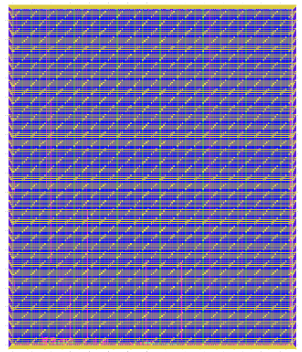Quick start for caravel_user_project
Dependencies
Docker: Linux || Windows || Mac with Intel Chip || Mac with M1 Chip
Python 3.6+ with PIP
Starting your project
To start the project you need to first create an empty Git project on Github and make sure your repo is public and includes a README
Open your Terminal. Create an empty folder to use as your Caravel workspace, and navigate to it.
# Create a directory and call it anything you want mkdir -p caravel_tutorial # navigate into the directory cd caravel_tutorial
Clone caravel_user_project and setup the git environment as follows
# Make sure that "caravel_example" matches the empty github repo name in step 1 git clone -b mpw-6b https://github.com/efabless/caravel_user_project caravel_example cd caravel_example git remote rename origin upstream # You need to put your empty github repo URL from step 1 git remote add origin <your github repo URL> # Create a new branch, you can name it anything git checkout -b <my_branch> git push -u origin <my_branch>
Now that your git environment is setup, it’s time to setup your local environment by running.
# make sure to change <directory_name> with the directory you created in step 2 # in this case it is caravel_tutorial export OPENLANE_ROOT=~/<directory_name>/openlane # you need to export this whenever you start a new shell export PDK_ROOT=~/<directory_name>/pdks # you need to export this whenever you start a new shell make setup
This command will setup your environment by installing the following:
caravel_lite (a lite version of caravel)
management core for simulation
openlane to harden your design
pdk
Now you can start hardening your design
To start hardening you project you need - RTL verilog model for your design for OpenLane to harden - A subdirectory for each macro in your project under
openlane/directory, each subdirectory should include openlane configuration files for the macromake <module_name>
For an example of hardening a project please refer to user_project_example
Integrate modules into the user_project_wrapper
Change the environment variables
VERILOG_FILES_BLACKBOX,EXTRA_LEFSandEXTRA_GDS_FILESinopenlane/user_project_wrapper/config.tclto point to your moduleInstantiate your module(s) in
verilog/rtl/user_project_wrapper.vHarden the user_project_wrapper including your module(s), using this command:
make user_project_wrapper
Run simulation on your design
You need to include your rtl/gl/gl+sdf files in
verilog/includes/includes.<rtl/gl/gl+sdf>.caravel_user_projectNOTE: You shouldn’t include the files inside the verilog code
# you can then run RTL simulations using make verify-<testbench-name>-rtl # OR GL simulation using make verify-<testbench-name>-gl # for example make verify-io_ports-rtl
Run the precheck locally
make precheck make run-precheck
You are done! now go to www.efabless.com to submit your project!
Caravel User Project Detailed Overview
Table of contents
Overview
This repo contains a sample user project that utilizes the caravel chip user space. The user project is a simple counter that showcases how to make use of caravel’s user space utilities like IO pads, logic analyzer probes, and wishbone port. The repo also demonstrates the recommended structure for the open-mpw shuttle projects.
Prerequisites
Docker: Linux || Windows || Mac with Intel Chip || Mac with M1 Chip
Python 3.6+ with PIP
Install Caravel
To setup caravel, run the following:
git clone https://github.com/efabless/caravel_user_project.git
cd caravel_user_project
make install
To remove caravel, run
make uninstall
By default caravel-lite is installed. To install the full version of caravel, run this prior to calling make install.
export CARAVEL_LITE=0
Caravel Integration
Repo Integration
Caravel files are kept separate from the user project by having caravel as submodule. The submodule commit should point to the latest of caravel/caravel-lite master/main branch. The following files should have a symbolic link to caravel’s corresponding files:
Openlane Makefile: This provides an easier way for running openlane to harden your macros. Refer to Hardening the User Project Macro using Openlane. Also, the makefile retains the openlane summary reports under the signoff directory.
Pin order file for the user wrapper: The hardened user project wrapper macro must have the same pin order specified in caravel’s repo. Failing to adhere to the same order will fail the gds integration of the macro with caravel’s back-end.
The symbolic links are automatically set when you run make install.
Verilog Integration
You need to create a wrapper around your macro that adheres to the
template at
user_project_wrapper.
The wrapper top module must be named user_project_wrapper and must
have the same input and output ports as the golden wrapper template. The wrapper gives access to the
user space utilities provided by caravel like IO ports, logic analyzer
probes, and wishbone bus connection to the management SoC.
For this sample project, the user macro makes use of:
The IO ports for displaying the count register values on the IO pads.
The LA probes for supplying an optional reset and clock signals and for setting an initial value for the count register.
The wishbone port for reading/writing the count value through the management SoC.
Refer to user_project_wrapper for more information.

Layout Integration
The caravel layout is pre-designed with an empty golden wrapper in the user space. You only need to provide us with a valid user_project_wrapper GDS file. And, as part of the tapeout process, your hardened user_project_wrapper will be inserted into a vanilla caravel layout to get the final layout shipped for fabrication.

To make sure that this integration process goes smoothly without having any DRC or LVS issues, your hardened user_project_wrapper must adhere to a number of requirements listed at User Project Wrapper Requirements .
Building the PDK
For more information about volare click here
# set PDK_ROOT to the path you wish to use for the pdk
export PDK_ROOT=<pdk-installation-path>
# use volare to download the pdk
# To change the default pdk version you can export OPEN_PDKS_COMMIT=<pdk_commit>
make pdk-with-volare
Running Full Chip Simulation
First, you will need to install the simulation environment, by
make simenv
This will pull a docker image with the needed tools installed.
Then, run the RTL simulation by
export PDK_ROOT=<pdk-installation-path>
# Run RTL simulation on IO ports testbench, make verify-io_ports
make verify-<testbench-name>-rtl
Once you have the physical implementation done and you have the gate-level netlists ready, it is crucial to run full gate-level simulations to make sure that your design works as intended after running the physical implementation.
Run the gate-level simulation by:
export PDK_ROOT=<pdk-installation-path>
# Run RTL simulation on IO ports testbench, make verify-io_ports
make verify-<testbench-name>-gl
This sample project comes with four example testbenches to test the IO port connection, wishbone interface, and logic analyzer. The test-benches are under the verilog/dv directory. For more information on setting up the simulation environment and the available testbenches for this sample project, refer to README.
User Project Wrapper Requirements
Your hardened user_project_wrapper must match the golden user_project_wrapper in the following:
Area
(2.920um x 3.520um)Top module name
"user_project_wrapper"Pin Placement
Pin Sizes
Core Rings Width and Offset
PDN Vertical and Horizontal Straps Width

You are allowed to change the following if you need to:
PDN Vertical and Horizontal Pitch & Offset

To make sure that you adhere to these requirements, we run an exclusive-or (XOR) check between your hardened user_project_wrapper GDS and the golden wrapper GDS after processing both layouts to include only the boundary (pins and core rings). This check is done as part of the mpw-precheck tool.
Hardening the User Project using OpenLane
OpenLane Installation
You will need to install openlane by running the following
export OPENLANE_ROOT=<openlane-installation-path>
# you can optionally specify the openlane tag to use
# by running: export OPENLANE_TAG=<openlane-tag>
# if you do not set the tag, it defaults to the last verfied tag tested for this project
make openlane
For detailed instructions on the openlane and the pdk installation refer to README.
Hardening Options
There are three options for hardening the user project macro using openlane:
Option 1 |
Option 2 |
Option 3 |
|---|---|---|
Hardening the user macro(s) first, then inserting it in the user project wrapper with no standard cells on the top level |
Flattening the user macro(s) with the user_project_wrapper |
Placing multiple macros in the wrapper along with standard cells on the top level |
ex: caravel_ibex |
For more details on hardening macros using openlane, refer to README.
Running OpenLane
For this sample project, we went for the first option where the user macro is hardened first, then it is inserted in the user project wrapper without having any standard cells on the top level.

To reproduce hardening this project, run the following:
# DO NOT cd into openlane
# Run openlane to harden user_proj_example
make user_proj_example
# Run openlane to harden user_project_wrapper
make user_project_wrapper
For more information on the openlane flow, check README.
Running MPW Precheck Locally
You can install the mpw-precheck by running
# By default, this install the precheck in your home directory
# To change the installtion path, run "export PRECHECK_ROOT=<precheck installation path>"
make precheck
This will clone the precheck repo and pull the latest precheck docker image.
Then, you can run the precheck by running
make run-precheck
This will run all the precheck checks on your project and will produce the logs under the checks directory.
Other Miscellaneous Targets
The makefile provides a number of useful that targets that can run LVS, DRC, and XOR checks on your hardened design outside of openlane’s flow.
Run make help to display available targets.
Run lvs on the mag view,
make lvs-<macro_name>
Run lvs on the gds,
make lvs-gds-<macro_name>
Run lvs on the maglef,
make lvs-maglef-<macro_name>
Run drc using magic,
make drc-<macro_name>
Run antenna check using magic,
make antenna-<macro_name>
Run XOR check,
make xor-wrapper
Checklist for Open-MPW Submission
✔️ The project repo adheres to the same directory structure in this repo.
✔️ The project repo contain info.yaml at the project root.
✔️ Top level macro is named
user_project_wrapper.✔️ Full Chip Simulation passes for RTL and GL (gate-level)
✔️ The hardened Macros are LVS and DRC clean
✔️ The project contains a gate-level netlist for
user_project_wrapperat verilog/gl/user_project_wrapper.v✔️ The hardened
user_project_wrapperadheres to the same pin order specified at pin_order✔️ The hardened
user_project_wrapperadheres to the fixed wrapper configuration specified at fixed_wrapper_cfgs✔️ XOR check passes with zero total difference.
✔️ Openlane summary reports are retained under ./signoff/
✔️ The design passes the mpw-precheck



